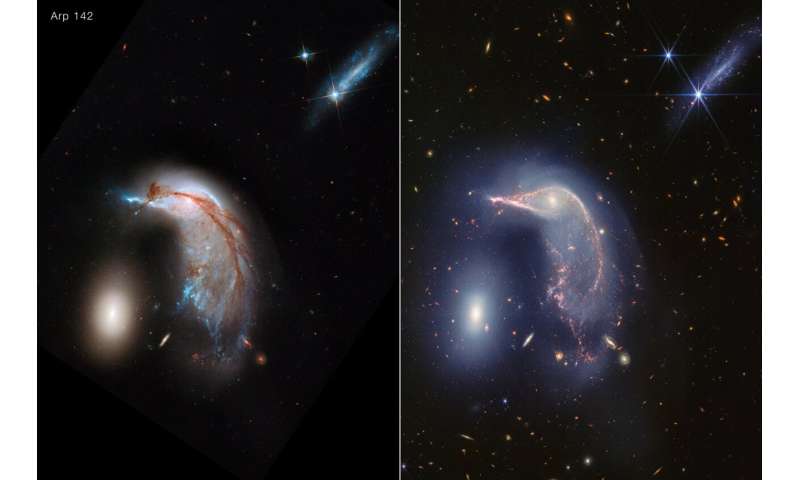phys.org | 2024 July 12
TY4YA Jac
- This penguin party is loud. The distorted spiral galaxy at center, the Penguin, and the compact elliptical galaxy at left, the Egg, are locked in an active embrace. A new near- and mid-infrared image from the James Webb Space Telescope, taken to mark its second year of science, shows that their interaction is marked by a faint upside-down U-shaped blue glow. Credit: NASA, ESA, CSA, STScI
A duo of interacting galaxies commemorates the second science anniversary of NASA's James Webb Space Telescope.
[…]
Their ongoing interaction was set in motion between 25 and 75 million years ago, when the Penguin (individually cataloged as NGC 2936) and the Egg (NGC 2937) completed their first pass. They will go on to shimmy and sway, completing several additional loops before merging into a single galaxy hundreds of millions of years from now.
Before their first approach, the Penguin held the shape of a spiral. Today, its galactic center gleams like an eye, its unwound arms now shaping a beak, head, backbone, and fanned-out tail.
Like all spiral galaxies, the Penguin is still very rich in gas and dust. The galaxies' "dance" gravitationally pulled on the Penguin's thinner areas of gas and dust, causing them to crash in waves and form stars. Look for those areas in two places: what looks like a fish in its "beak" and the "feathers" in its "tail."
Surrounding these newer stars is smoke-like material that includes carbon-containing molecules, known as polycyclic aromatic hydrocarbons, which Webb is exceptional at detecting. Dust, seen as fainter, deeper orange arcs also swoops from its beak to tail feathers.
In contrast, the Egg's compact shape remains largely unchanged. As an elliptical galaxy, it is filled with aging stars, and has a lot less gas and dust that can be pulled away to form new stars. If both were spiral galaxies, each would end the first "twist" with new star formation and twirling curls, known as tidal tails.
[…]
Now, look to the top right to spot a galaxy that is not at this party. This edge-on galaxy, cataloged PGC 1237172, is 100 million light-years closer to Earth. It's also quite young, teeming with new, blue stars.
Want one more party trick? Switch to Webb's mid-infrared-only image to see PGC 1237172 practically disappear. Mid-infrared light largely captures cooler, older stars and an incredible amount of dust. Since the galaxy's stellar population is so young, it "vanishes" in mid-infrared light.
[…]
more
ESA
download


